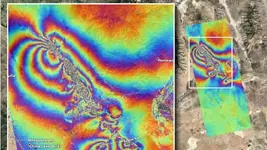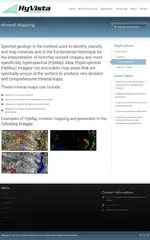It seems one sattelite has the capability to see minerals...
To aid mining operations in their search for suitable sites and to simply keep a long-term record of the world’s resources, the U.S. Geological Survey (USGS) two years ago initiated the Global Mineral Resource Assessment Project. The goal of the project is to construct a series of reports outlining where the world’s known metal ore deposits such as gold, copper, and iron occur and where new deposits are likely to be found.
As part of this ambitious effort, geologist Larry Rowan and a team of researchers at the USGS are now developing ways to locate potentially mineralized areas from space. Using the new Advanced Spaceborne Thermal Emissions and Reflection Radiometer (ASTER) instrument aboard the Terra satellite, they are attempting to find areas likely to contain copper in Iran and western Pakistan. If their tests are successful, then ASTER and future satellites could aid geologists in pinpointing any number of metal ores from aluminum to tin.
*
*
Tailing piles rise beside the abandoned buildings of the Kennecott Copper Mine in Alaska. This mine site was discovered when prospectors spied unusual green rocks. New satellites are allowing modern-day prospectors to map mineral deposits from afar. (Image courtesy*Historic American Engineering Record)
“For now, ASTER is really the only practical solution. It is the only instrument up there with the combination of spectral capability and geographic coverage to locate potentially mineralized areas on a global or regional scale,” says Rowan. He explains that mapping the world’s minerals could not be accomplished on the ground or by airplane alone. The costs would be enormous. The only feasible way to carry out such a large survey is through the use of remote sensing satellites. The problem with previous satellite instruments, however, was that while they could view large sections of the Earth, they didn’t have the ability to detect the geological information needed to reveal metal ore.
The ASTER instrument, launched aboard NASA’s Terra satellite in December 1999, was designed in part to remedy this problem. The instrument moves in a nearly circular orbit approximately from pole to pole around the Earth and measures a wide range of visible and infrared solar radiation from the surface of our planet. ASTER has a spatial resolution of up to 15 meters and can gather stereoscopic (3-D) images of the Earth, making it ideal for mapping mountains and rock formations.
Rowan and the USGS team decided to test ASTER’s abilities in mapping copper ore. Used in everything from electrical systems to compact discs to air conditioners, copper is one of the more expensive and useful non-precious metals. As a proving grounds, the USGS team turned their attention to a string of known copper deposits located across a 500-mile-long arc that extends from the northwest corner of Iran through the Zagros Mountains and into western Pakistan. Since this area is cloud free most of the year and many of the deposits have been mined since the beginning of the Bronze Age, the region is ideal for trying out ASTER.
“The types of deposits that lend themselves to remote sensing in Iran are intrusive deposits,” says Rowan. He explains that intrusive ore deposits form deep underground. Magma from the Earth’s mantle percolates into the Earth’s crust in areas where two tectonic plates collide or above “hotspots” in the mantle. As this magma solidifies to create rocks such as granite, the intense heat and pressure sometimes acts in concert with underground water to forge copper deposits at the boundary between the cooling magma and the existing crust. In Iran, the intrusive deposits first took shape between 10 and 70 million years ago at the boundary of the Arabian Plate and the Eurasian Plate. The copper deposits formed thousands of feet under the Earth’s surface. Continued uplift and years and years of water, ice, and wind erosion have exposed the copper ore to the Earth’s surface for mining.
In looking for such intrusive deposits, geologists must focus in on those large features such as faults and folds and mountains that indicate possible ore-bearing intrusive rocks. In ASTER images, such large-scale features are usually readily apparent. Narrowing the search to specific locations among these intrusive rocks, however, is considerably more involved. Like most metals, copper doesn’t exist in abundance on the Earth’s surface. In fact, copper only makes up 0.00007 percent of the Earth’s crust. So even in areas where deposits are common, copper is not easy to spot.
“What we do is look for other minerals that generally indicate that copper is in the region,” says Rowan. Fortunately, the same geothermal processes that create copper deposits usually give rise to other minerals, known as alteration minerals, that tend to be more abundant and more noticeable. Minerals such as muscovite, alunite, kaolnite, and iron sulfide are typically found in abundance around copper deposits. Some of these, such as iron sulfide, react with surface water and oxygen to form highly visible markers (Rowan et al. 2002). “If you’ve ever been to an old mining site in Colorado, the presence of the resulting sulfates can be seen in the yellowish to brown red cast they leave in the water,” says Rowan.
Though uncovering alteration minerals is much easier than finding an isolated copper vein, geologists still must go around collecting, testing for, and mapping the alteration minerals in large rock formations. ASTER, however, should be able to significantly reduce the amount of work and cost involved in this process. All told, ASTER can detect 14 different wavelengths (colors) of light reflected and emitted from the surface of the Earth. Generally, everything on the Earth’s surface reflects certain colors of light and absorbs others. Green grass, for instance, absorbs all colors in the visible spectrum except green. Alteration minerals, though usually much more subtle in color, absorb and reflect specific bands as well. Rowan explains that nine of the satellite instrument’s sensors that detect light in the visible and near-infrared (light past red on the color spectrum) range are particularly sensitive to the wavelengths associated with alteration minerals.




 I'm sure they'll take my 20% off coupon those things can't be cheap.
I'm sure they'll take my 20% off coupon those things can't be cheap.

 ) their data . The article said they were currently scanning the United States for gas, oil ,and Water........ Do a goggle search on Air Born Imaging System and see what you come up with. I would imagine that big mineral / gold company's would still use this TechKnowledgy .
) their data . The article said they were currently scanning the United States for gas, oil ,and Water........ Do a goggle search on Air Born Imaging System and see what you come up with. I would imagine that big mineral / gold company's would still use this TechKnowledgy .